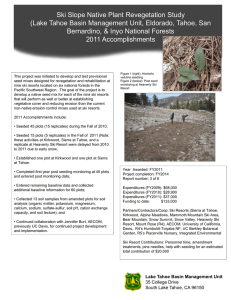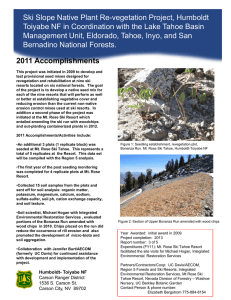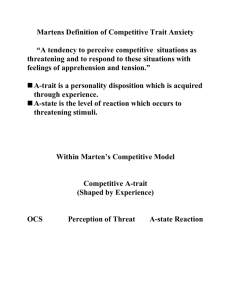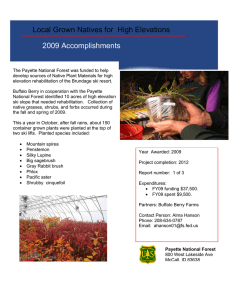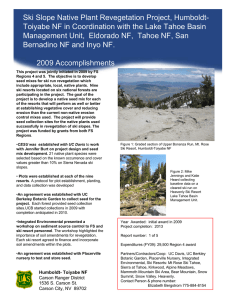The Effects of Ski Resorts in the Lake Tahoe Region... Population Dynamics of the American Marten
advertisement
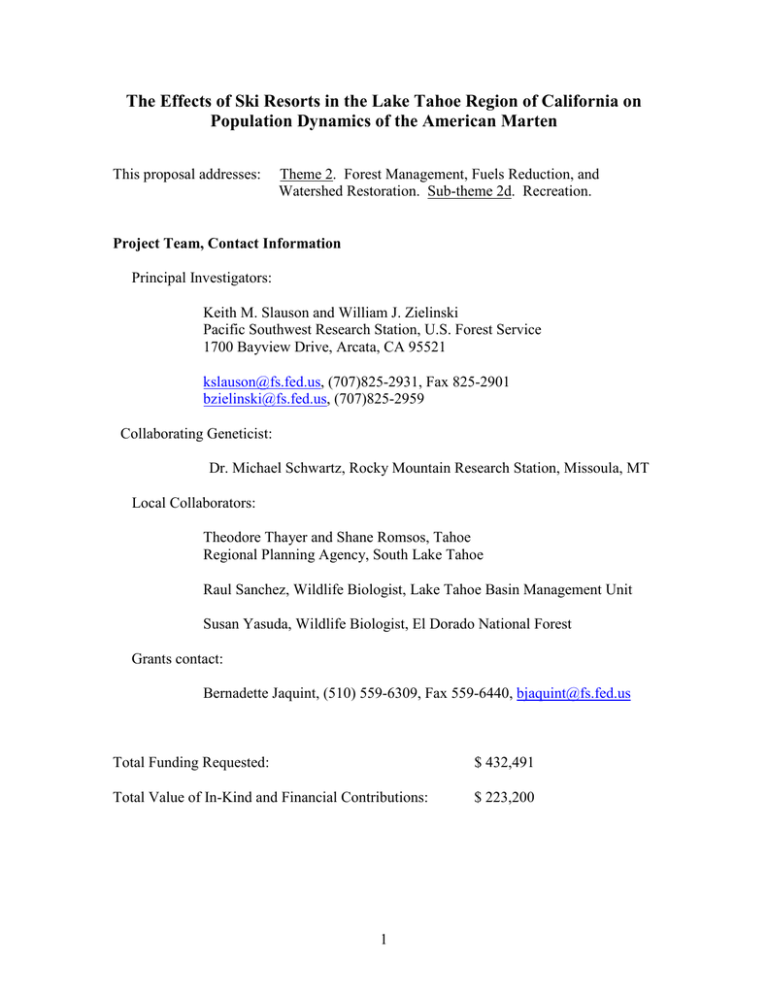
The Effects of Ski Resorts in the Lake Tahoe Region of California on Population Dynamics of the American Marten This proposal addresses: Theme 2. Forest Management, Fuels Reduction, and Watershed Restoration. Sub-theme 2d. Recreation. Project Team, Contact Information Principal Investigators: Keith M. Slauson and William J. Zielinski Pacific Southwest Research Station, U.S. Forest Service 1700 Bayview Drive, Arcata, CA 95521 kslauson@fs.fed.us, (707)825-2931, Fax 825-2901 bzielinski@fs.fed.us, (707)825-2959 Collaborating Geneticist: Dr. Michael Schwartz, Rocky Mountain Research Station, Missoula, MT Local Collaborators: Theodore Thayer and Shane Romsos, Tahoe Regional Planning Agency, South Lake Tahoe Raul Sanchez, Wildlife Biologist, Lake Tahoe Basin Management Unit Susan Yasuda, Wildlife Biologist, El Dorado National Forest Grants contact: Bernadette Jaquint, (510) 559-6309, Fax 559-6440, bjaquint@fs.fed.us Total Funding Requested: $ 432,491 Total Value of In-Kind and Financial Contributions: $ 223,200 1 PROPOSAL NARRATIVE A. Justification Statement The American marten (Martes americana) is a carnivore that occupies high-elevation (5,000-10,000 feet) late-successional conifer forests in the Sierra Nevada (Spencer et al. 1983, Zielinski et al. 2005). The marten is a ‘Sensitive Species’ in Region 5 of the Forest Service (Macfarlane 1994) and a ‘Species of Special Concern’ for the California Department of Fish and Game (Bryliski et al. 1997). Current management direction for American marten in the Lake Tahoe Basin comes from several U.S. Forest Service documents and the Tahoe Regional Planning Agency (TRPA). The 2001 Sierra Nevada Forest Plan Amendment (SNFPA) addressed marten (App. E-55) and listed development of winter recreation as a potential threat to the species. This was presumed to be due to fragmentation of forest cover usually associated with this management practice. The 2004 SNFPA carried forward den site guidelines for martens, but eliminated 2001 SNFPA vegetation standards and guidelines for developed recreation projects (USDA 2001, 2004). This left decisions for management of marten with regard to developed recreation to the Lake Tahoe Basin Management Unit (LTBMU). TRPA’s goals and policies (TRPA 1986) provide for the maintenance of “suitable habitats for all indigenous species of wildlife without preference to game or non-game species through maintenance of habitat diversity”. There are several potential future changes to the management guidelines for marten in the LTBMU. Revisions to the LTBMU forest plan and TRPA regional plan are underway which are likely to establish the American marten as a special interest species. The proposed inclusion of the marten as a special interest species followed guidelines set forth by the 2005 National Forest Management Act and professional opinion of local scientists and managers. Elevation of the management level for American martens in the Lake Tahoe Region will require managers to have an increased understanding of threats to the species and how they can prescribe management and mitigation alternatives to favor its persistence. Furthermore, several ski areas are planning expansion. Without information on whether these are likely to increase impacts on martens, managers cannot evaluate and potentially mitigate negative effects. The proposed research project described herein directly addresses the “development of environmental carrying capacity guidelines for developed recreation [ski resorts] currently allowed [existing resorts] and proposed [proposed resort expansion]” (Theme 2, Subtheme: Recreation). The American marten, due to its specialization on old forests and large area requirements, is one of the best species of management concern to use to evaluate the effects of ski resorts in the high elevation forests and to use to develop carrying capacity guidelines for forest management in the Lake Tahoe Region. Letters of support for this project from the Tahoe Regional Protection Agency, Lake Tahoe Basin Management Unit, and El Dorado National Forest can be found in Appendix 1. 2 B. Background and Problem Statement High-elevation conifer forests of the Sierra Nevada have historically provided some refuge from human impacts including trapping and timber harvest, but these forests have increasingly become focal areas for winter recreation. Because martens are active yearround and are most energetically stressed during winter, winter recreation has the potential to have significant negative impacts. The two types of winter recreation most likely to negatively affect martens are snowmobiling and creation and operation of ski resorts. There have been very few studies on the effects of these types of recreation on martens. However, a recent study in the Sierra Nevada found that managed snowmobile use did not affect marten occupancy or activity patterns (Zielinski et al. in review). Ski resorts have more permanent and concentrated effects on martens and their habitat than snowmobiling. There are approximately 25 ski resorts in the Sierra Nevada, nearly all occur within the range of the marten. The Lake Tahoe region includes about half of these resorts, constituting the highest density of resorts in the Sierra Nevada and one of the highest in North America. To create ski runs, chair lifts, and facilities, trees are removed, creating open areas and fragmenting previously contiguous forest. Martens typically avoid open areas lacking overhead cover or tree boles that provide vertical escape routes from predators (Drew 1995), are more susceptible to predation if they must cross such areas, and have been shown to avoid areas when 25-30% of mature forest is removed (Bissonette et al. 1997). Snow compaction from grooming alters surface consistency making it easier for larger-bodied carnivores (e.g., coyotes) which, unlike martens are not adapted for deep, soft snow, to expand their winter ranges and compete with or prey on martens. Skiers and staff are active during the majority of the day at high densities and during the night conducting grooming activities, creating a higher likelihood for marten-human encounters and their associated disturbances (e.g., decreased frequency of prey captures due to interruptions while hunting). Finally, ski resort effects are not limited to winter, as permanent effects (e.g., fragmentation) are present yearround, and because many resorts are developing summer recreation (e.g., hiking, mountain biking). Ski areas have some potential beneficial effects on martens as well. Martens have been reported using anthropogenic food sources (e.g., dumpsters), using resort structures (e.g., chalets, buildings) as rest sites, and detected via snow tracks under lift lines. Food available at ski areas, from humans, may also attract small mammals which, in turn, may be preyed on by martens. We need to evaluate the sum total of costs and benefits of ski areas on marten populations and we propose to do so by studying the demographic health of populations in ski areas compared to similar areas unaffected by ski operations. Kucera (2004) conducted the only intensive study of martens in a ski area. His work occurred at Mammoth Mountain ski area from 2002-2003. Within the 1855 ha operations area 12 martens were captured, yielding a density of 6.47 martens per 1000 ha. However, 10 individuals were males, only 1 was female, and 1 was of unknown sex, resulting in a highly skewed proportional sex ratio of 0.91. Studies of martens adjacent to Mammoth (Kucera 1997) and in five other areas of North America (Buskirk and Lindstedt 1989) 3 obtained much more balanced proportional sex ratios of 0.57 and 0.52-0.62, respectively. The single female at the Mammoth ski area did raise two kits, but did not use developed areas and only used natural rest sites. Martens appeared to move away from the ski area and into unmanaged forest after winter. Kucera (2004) suggested this fits a seasonal use pattern where martens occupy ski areas during winter, when natural prey is least available and human-supplied food is most plentiful, then move into unmanaged forests in spring. Evidence exists that martens are present at many of the ski resorts in the Lake Tahoe region. Surveys conducted at Heavenly ski resort have demonstrated that martens primarily occupy the central and southern portions of the resort, particularly during winter (Bartholomew & Associates 1993, Cablk and Spaulding 2002). Surveys detecting martens and sightings of martens have occurred on or near several other resorts in the region (e.g., Sierra at Tahoe, S. Yasuda pers. comm.; Alpine Meadows, K. Boatner pers. comm.; Homewood, K. Slauson pers. obs.). Although survey detections and sightings provide information on occurrence, occurrence alone is insufficient to evaluate the effects of a ski resort on martens. First, these surveys did not compare marten data from ski resorts with unaffected (control) areas. Second, these surveys documented presence of martens only, which provides no information on the demographic health of the population. Martens can occur in the area but at very low densities, or the populations may have skewed sex or age ratios or high turnover rates, all suggesting a population that is not sustainable. Kucera’s (1994) study provides compelling, if only preliminary, information suggesting that Mammoth ski area does not support a self-sustaining marten population due to lack of females. If these results are consistent across ski resorts, their high density in the Lake Tahoe Region could have significant effects on the regional marten population. To investigate this possibility, we propose a research project focused on marten demographic parameters (e.g., sex ratio, age, reproduction) and which compares data from ski resorts to nearby control areas. Our proposed research design will improve upon previous research efforts by including multiple ski resorts and control areas, resulting in a robust design for detecting effects and a broad scope of inference. C. Goals, Objectives, and Hypotheses to be Tested The overall goal is to identify whether ski resorts have a net negative, neutral, or positive effect on marten populations in the Lake Tahoe region. We will gather information necessary to determine whether any of the following characteristics differ when ski areas and control areas are compared: 1. 2. 3. 4. 5. 6. loss and fragmentation of suitable habitat marten density marten seasonal movements marten age structure and sex ratio proportion of female martens that reproduce marten population stability 4 For each characteristic listed, our null hypothesis is that there is a negative difference between the habitat or marten population characteristic at control sites versus ski areas. D. Approach, Methodology, and Geographic Location of Research Proposed Study Design Our proposed design compares 3 pairs of treatment (ski resorts) and control areas (non ski resorts). To select ski resorts, we reviewed information on the distribution of martens in the Lake Tahoe region and selected three resorts well within the current range of martens and that occupied locations composed of large amounts of potential marten habitat. This process resulted in the selection of the Heavenly, Sierra at Tahoe, and Alpine ski resorts (Figure 1). Each resort was then paired with a single control site that best matched it with respect to the overall amount, composition, and suitability of marten habitat as well as major topographic characteristics. Treatment areas will then be compared to controls to determine whether population values for the treated differ from the values from control areas. By including several treatment and control areas, we include both replication and variation in ski areas, which will allow for a broad scope of inference. The Sierra at Tahoe resort is outside the Lake Tahoe Basin, but is essential for inference to the effects of ski areas within the basin. None the less, we will be using nonSNPLMA funds to support the work conducted outside the Lake Tahoe Basin (see budget for details). Control Area Selection The three control areas for this project were selected based on the topographic (elevation range and major aspect) similarity, vegetation similarity, and proximity to each ski resort operations area. Topographic and vegetative similarity was assessed using digital elevation models and remotely sensed vegetation data based on California Wildlife Habitat Relationships system (CWHR, Mayer and Laudenslayer 1988) habitat types in a geographic information system (GIS). Control areas were chosen that had the same basic forest type and size class distribution as present at each ski resort operations area prior to its development. We used pre-development era aerial photos to determine the composition of forest habitats at each ski area prior to development. Sites were selected that were in close proximity to each ski resort operations area to facilitate assessing seasonal movement, directional dispersal of young, and to better control for environmental variability (Figure 1). Statistical Considerations Prior to committing to a particular study approach, we conducted a simulation exercise to investigate the relationship between the potential number of martens that could occupy a typical ski area and the parameters of interest. Because martens have large home ranges, it may be possible that ski areas only have the potential to affect a few individuals which would make the study objectives difficult to achieve. Additionally, when sample sizes are too small it becomes difficult to statistically detect differences. 5 We estimated the potential amount of suitable habitat available for each of the 3 ski areas. To accomplish this, we used the CWHR types and size classes suitable for martens and GIS vegetation coverages to identify the amount of potentially suitable habitat in each ski area. The Heavenly ski area contained approximately 1500 ha of suitable habitat while Sierra at Tahoe and Alpine Meadows ski areas contained about 1000 ha of suitable habitat. We created a matrix to estimate marten density over a range of different sizes of male and female home ranges in 1000 and 1500 ha of suitable habitat (Table 1). Assuming complete saturation of suitable habitat, we conservatively estimate that 1000 and 1500 ha of suitable habitat could support 4.7-8.0 and 7.1-12.0 martens, respectively. Using these numbers, we conducted a statistical power analysis to investigate the range of differences that were statistically distinguishable for several parameters of interest given the small number of individuals that probably occupy study areas of 10001500 ha. We sought experimental designs that would have a minimum 80% chance of detecting a significant difference, if it in fact occurred (i.e., statistical power = 0.80). We calculated power for incremental changes in the observed difference between controls and ski areas and for a range of potential marten densities. Because we did not have pilot data, standard deviations were estimated from a Poisson distribution, an acceptable approach when the counts involved are small. Each calculation was conducted with the probability of a type one error (alpha) < 0.15 and using a 1-tailed test (We thank J. Baldwin, PSW Statistician for analysis review). We investigated the density parameters, including male, female, and total density, assuming a 10-50% change in marten density between ski area and controls (Figure 2). Using our design of 3 pairs of treatment and controls, we will be able to detect a 33-36% (2-4 marten difference) decline in the density of martens. A difference in total density of ≥ 4 martens begins to become biologically relevant, given only 4-16 individuals likely exist in an area of similar habitat, constituting a 25-100% reduction in the number of individuals present. Furthermore, a reduction of female density >2 can begin to significantly reduce reproductive capability in small populations. Thus, our design is well suited to detect differences in marten density that are biologically relevant with statistical rigor. Ski Area Development Forest Fragmentation Analysis The sensitivity of martens to the loss and fragmentation of forest habitats is one the main threats that ski are development poses to martens. Martens have been shown to avoid areas when 25-30% of mature forest has been removed (Bissonette et al. 1997, Potvin et al. 2000). These studies have all taken place in the context of industrial timber harvest and there have been no investigations evaluating the effects of forest fragmentation from ski resort development. To quantify the changes that ski resort development has caused to forested landscapes and to evaluate the responses by martens, we will conduct a fragmentation analysis using pre- and post-development vegetation information. We will measure fragmentation similarly as previous studies (e.g., amount of mature forest lost / unit area) and through additional metrics (e.g., remnant patch size) 6 using spatial statistical methods (e.g., Fragstats, McGarical and Marks 1995). We will explicitly test the levels of fragmentation present on ski areas with marten presence and demographic characteristics (e.g., whether females are present or breed in highly fragmented areas). This analysis will provide a means to evaluate the vegetation changes that have occurred and provide predictive tools for managers to evaluate whether other ski resorts or future expansion of ski resort development will have negative impacts to martens. Density Estimation and Demographic Characteristics To completely census all individuals in each study area, a systematic grid will be established covering all suitable marten habitat. The grid will be composed of cells with an area of 100 ha, which is a size similar to a small female marten home range. Within each grid cell 2-3 stations will be placed where, depending on the season, either live traps (spring/summer) or hair snares (winter) will be established. We will determine density by identifying all individuals in each study area. The effective trapping area will be calculated by buffering individual locations detected along the edge of the study area by the average radius of a male or female home range (Simon 1980, Spencer 1981). During the spring/summer season, each individual captured will be chemically immobilized and examined to determine the sex, age class, condition (weight, evidence of injury), and reproductive status (females lactating, number of teats from which milk can be expressed, number of suckling rings). One lower first premolar will be removed for cementum annuli analysis to determine age (Poole et al. 1994). Small tufts of tail and dorsal body hair will be removed for DNA fingerprinting and parentage analysis (Riddle et al. 2003). Genetic analysis will be conducted under the direction of Dr. Schwartz at the USFS Carnivore Genetics Laboratory. Each individual will receive a uniquely numbered passive integrated transponder tag for future individual identification. Repeat Sampling to Determine Population Dynamics Although single season ‘snapshots’ of density and sex ratio may provide some clues to what is occurring in ski and reference areas, estimating density without knowledge of survival and reproduction can be misleading (van Horne 1983). The key question we plan to address is whether marten populations on ski areas are any less productive or stable than those in control areas. We will use the full suite of demographic parameters, measured over several years, to parameterize a matrix structured population model (Table 2) to determine the trajectory (declining, stable, increasing) of each population (Caswell 1989). Because we are interested in how the conditions in each study area (ski and control areas) are affecting the animals that reside there, we will conduct modeling with and without the effect of immigration from outside each population, to remove the ‘rescue’ effect immigrants can have on declining populations. Repeat sampling over the course of at least 3 years will be necessary to estimate the demographic parameters. In the first year, all animals will be marked and age and reproductive condition (females) determined. In the second year, new animals will be 7 marked, and previously marked individuals provide first estimates of persistence (surviving and not emigrating) and absence (due to mortality or emigration). The third year produces the second estimates of persistence and absence for each population and the first estimates of variation for these parameters. Having ≥ 2 estimates of each demographic parameter is the minimum amount of information needed to investigate variation in each parameter and to begin modeling population dynamics. Each resampling period will occur during the spring/summer reproductive season so individual identification as well as the full set of demographic parameters can be collected on each individual. The timing of sampling was chosen such that the kits would be >2 months of age and weaned (Mead 1994), but evidence of lactation would still be present in females with kits. To reduce the potential for negative effects of trapping females with kits and to increase trapping efficiency, each trap will be fitted with a radio collar that will transmit only when the trap door closes. Re-sampling efforts will likely include new, unmarked individual martens in each study area. We will use DNA fingerprinting and parentage analysis to determine the parents of each individual which will, in turn, help us determine if individuals were born within a study area or originated elsewhere. E. Strategy for Engaging with Managers The development of this study plan and proposal has already led to a working relationship with managers in the Lake Tahoe region. The letters of support for this project (Appendix 1) are a testament to our engagement with managers. We have and will continue to collaborate with local managers (e.g., TRPA, LTBMU, El Dorado National Forest, ski resort staff) to conduct this study. Upon completion, we will present and discuss the findings during a regional meeting where all interested managers will be invited to attend. Managers will be provided an opportunity to review draft final reports and we will consider their input carefully. F. Deliverables/Products Progress reports will be completed annually and final report prepared at the conclusion of the study. We will present the research findings in public and scientific meetings both in the Lake Tahoe Region and elsewhere. We will seek to publish this study in an appropriate professional scientific journal. G. Schedule of Milestones/Deliverables (quarterly progress reports and invoicing). Phase I (see budget section) of this study will begin in the winter (December-March) of 2008-2009 and phase II will begin in late spring/summer (May-July) of 2009. Phase III, repeating the late spring demographic sampling from phase II, will be conducted in the late springs/summers of 2010 and 2011. Quarterly brief progress reports and invoicing will be completed by the 1st of September, December, March, and June. Annual progress reports will be prepared by 31st of September of 2009 and 2010. The final report will be completed by 31st December of 2011. 8 III. TABLES AND FIGURES Table 1. Marten density matrix for the number of male and female home ranges saturating hypothetical areas of 1000 and 1500 ha of suitable habitat. Shaded cells identify the most likely range of densities to expect based on average male and female home range sizes from California. 1a. 1000 ha suitable habitat. 150 200 250 300 350 400 450 500 550 600 150 13.3 11.7 10.7 10.0 9.5 9.2 8.9 8.7 8.5 8.3 200 11.7 10.0 9.0 8.3 7.9 7.5 7.2 7.0 6.8 6.7 250 10.7 9.0 8.0 7.3 6.9 6.5 6.2 6.0 5.8 5.7 300 10.0 8.3 7.3 6.7 6.2 5.8 5.6 5.3 5.1 5.0 350 9.5 7.9 6.9 6.2 5.7 5.4 5.1 4.9 4.7 4.5 400 9.2 7.5 6.5 5.8 5.4 5.0 4.7 4.5 4.3 4.2 450 8.9 7.2 6.2 5.6 5.1 4.7 4.4 4.2 4.0 3.9 500 8.7 7.0 6.0 5.3 4.9 4.5 4.2 4.0 3.8 3.7 550 8.5 6.8 5.8 5.1 4.7 4.3 4.0 3.8 3.6 3.5 600 8.3 6.7 5.7 5.0 4.5 4.2 3.9 3.7 3.5 3.3 500 13.0 10.5 9.0 8.0 7.3 6.8 6.3 6.0 5.7 5.5 550 12.7 10.2 8.7 7.7 7.0 6.5 6.1 5.7 5.4 5.2 600 12.5 10.0 8.5 7.5 6.8 6.3 5.8 5.5 5.2 5.0 1b. 1500 ha suitable habitat. 150 200 250 300 350 400 450 500 550 600 150 20.0 17.5 16.0 15.0 14.3 13.8 13.3 13.0 12.7 12.5 200 17.5 15.0 13.5 12.5 11.8 11.3 10.8 10.5 10.2 10.0 250 16.0 13.5 12.0 11.0 10.3 9.8 9.3 9.0 8.7 8.5 300 15.0 12.5 11.0 10.0 9.3 8.8 8.3 8.0 7.7 7.5 350 14.3 11.8 10.3 9.3 8.6 8.0 7.6 7.3 7.0 6.8 9 400 13.8 11.3 9.8 8.8 8.0 7.5 7.1 6.8 6.5 6.3 450 13.3 10.8 9.3 8.3 7.6 7.1 6.7 6.3 6.1 5.8 Table 2. Population matrix for the demographic parameters that will be collected for each study area over multiple re-sampling seasons. An X indicates data will be collected in that cell during the sampling occasion. Persistence Absence Immigration Sampling (Survivors not Local (Deaths + From another Occasion Emigrating) Recruitment Immigrants) Population ____________________________________________________________________ M F M F M F M F ____________________________________________________________________ First Year X X Second Year X X X X X X X X Third Year X X X X X X X X ____________________________________________________________________ Example Diagnostic: (Persistence + Local Recruitment) >< (Absence) If >, then the population is stable or increasing If<, then the population is decreasing 10 Figure 1. Locations of the ski resorts and paired control study areas. 11 Figure 2. Results of a 1-tailed, paired t-test power analysis to detect a -10-50% change in density difference between 3 ski areas and 3 control areas with alpha = 0.15. The standard deviation was estimated using a Poisson distribution. Three density values (8, 10, and 12 martens / 1500 ha) were used to simulate the range of densities expected. Power 1 0.9 0.8 0.7 0.6 0.5 0.4 0.3 8 Martens 10 Martens 12 Martens 0.2 0.1 0 -10 -20 -30 -40 Percent Change 12 -50 VII. Literature Cited Bartholomew, H. and Associates. 1993. Heavenly ski resort forest carnivore surveys. Unpublished report. 2233 Watt Ave, Suite 330, Sacramento, CA. Bissonette, J.A., D.J. Harrison, C.D. Hargis, and T.G. Chapin. 1997. The influence of spatial scale and scale-sensitive properties on habitat selection by American marten. Pages 368-385 in J.A. Bissonette, editor. Wildlife and Landscape Ecology. Springer-Verlag, New York, New York, USA. Brylski, P. V., P. W. Collins, E. D. Pierson, W. E. Rainey. 1997. Mammal species of special concern in California. Report submitted to California Department of Fish and Game, Sacramento, California. Buskirk, S. W. and S. L. Lindstedt. 1989. Sex biases in trapped samples of the Mustelidae. Journal of Mammology. 70:88-97. Cablk, M. E. and S. Spaulding. 2002. Baseline and initial monitoring assessment of Martes americana, the American marten, at Heavenly Ski resort, Lake Tahoe. U. S. Forest Service, Lake Tahoe Basin Management Unit. 87 p. Caswell, H. 1989. Matrix population models. Sinauer Associates, Sunderland, USA. Mass., Drew, G. S. 1995. Winter habitat selection by American marten (Martes americana) In Newfoundland: Why old growth? Dissertation, Utah State University. Logan. 83 p. Kucera, T. 1997. Ecology of American martens on the Inyo National Forest. Unpublished report, Department of Environmental Science, Policy, and Management, University of California, Berkeley. Kucera, T. 2004. Ecology of American martens on the Mammoth Ski area. Unpublished report. Macfarlane, D. 1994. National Forest System status information. Pages 176-184 in: L. F. Ruggiero et al. (eds.). The scientific basis for conserving forest carnivores: American marten, fisher, lynx, and wolverine. USDA General Technical Report RM-254. Mayer, K. E., and W. F. Laudenslayer. 1988. A guide to wildlife habitats of California. California Department of Forestry and Fire Protection, Sacramento, California. McGarigal, K., and B. J. Marks. 1995. FRAGSTATS: spatial pattern analysis program for quantifying landscape structure. U.S. Forest Service Pacific Northwest Research Station, General Technical Report PNW-GTR-351. 18 Mead, R. A. 1994. Reproduction in Martes. in S. W. Buskirk, A. S. Harestad, M. G. Raphael, and R. A. Powell, editors. Martens, sables, and fishers: biology and conservation. Comstock Publishing Associates, Ithaca, New York, USA. Poole, K., G. Matson, M. A. Stirckland, A. Magoun, R. Graf, L. Dix. 1994. Age and sex determination for American martens and fishers. In: Buskirk SW, Harestad A, Raphael M., Powell R. (eds) Martens, sables and fishers: biology and conservation. Cornell University Press, Ithaca, NY. Potvin, F., L. BClanger, and K. Lowell. 2000. Marten habitat selection in a clearcut boreal landscape. Conservation Biology 14:844-857. Riddle AE, Pilgrim KL, Mills LS, McKelvey KS, Ruggiero LF. 2003. Identification of mustelids using mitochondrial DNA and non-invasive sampling. Conservation Genetics, 4, 241–243. Simon, T. L. 1980. An ecological study of the pine marten in the Tahoe National Forest. M.S. thesis. California State University, Sacramento, CA. 143 p. Spencer, W. D. 1981. Pine marten habitat preferences at Sagehen Creek, California. . M. S. thesis. University of California, Berkeley. 121 p. Spencer, W. D., R. H. Barrett, et al. 1983. Marten habitat preferences in the northern Sierra Nevada. Journal Wildlife Management 47: 1181-1186. TRPA. 1986. Regional Plan for the Lake Tahoe Basin Goals and Policies, Tahoe Regional Planning Agency, Stateline, NV, USA USDA. 2001. Sierra Nevada Forest Plan Amendment Final Environmental Impact Statement, Volume 4, Appendix E. United States Department of Agriculture, U.S. Forest Service, Pacific Southwest Region. USDA. 2004. Sierra Nevada Forest Plan Amendment Final Environmental Impact Statement, Record of Decision. United States Department of Agriculture, U.S. Forest Service, Pacific Southwest Region. van Horne, B. 1983. Density as a misleading indicator of habitat quality. Journal of Wildlife Management. 47:893-901. Zielinski, W. J., R. L. Truex, F. V. Schlexer, L. A. Campbell, and C. R. Carroll. 2005. Historical and contemporary distributions of carnivores in forests of the Sierra Nevada, California, USA. Journal of Biogeography 32:13851407. 19 Zielinski, W. J., K. M. Slauson, A. E. Bowles. In review. The effect of off-highway vehicle use on the American marten in California, USA. Journal of Wildlife Management. 20

